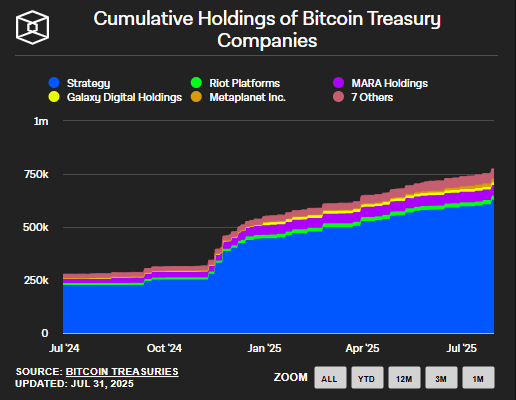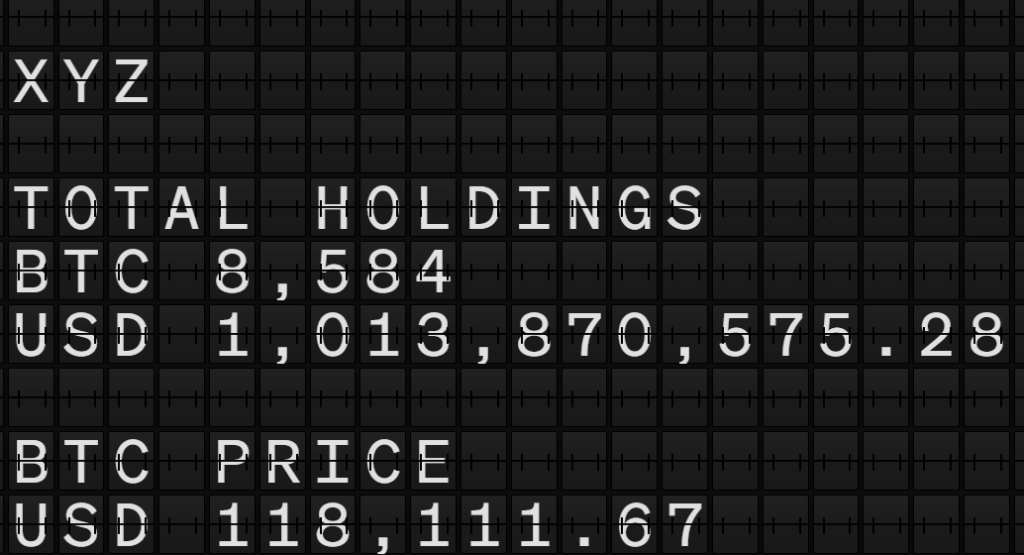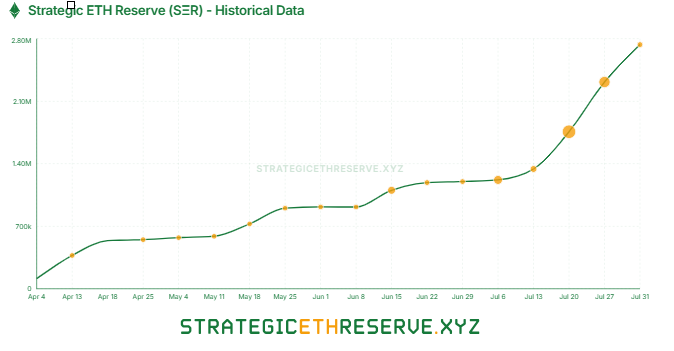Some bet everything to Bitcoin as digital gold financed with debt, others adopt it cautiously.
A group prefers Ethereum’s performance, ignoring the risks of a bubble.
A few years ago, corporate joint rooms dealt with a simple question: “Should we buy Bitcoin?” In 2025, that question looks like a distant echo. Now, the dilemma is more thorny: what digital asset adopt and how to navigate the risks without crashing.
On the one hand some corporations are inclined to Bitcoin (BTC), the “digital gold” that promises refuge against inflation, while others prefer Ethher (ETH), the native currency of the Ethereum network.
This is not just choosing between two digital assets: it is A shock of financial philosophies that will define how corporations manage their capital In the next decade.
From frantic accumulations of Bitcoin financed with debt to cautious diversifications and a silent boom towards Ethereum’s performance potential, companies are playing everything. But in a market on the edge of a speculative bubble, each strategy takes a time bomb.
Trend 1: accumulation of Bitcoin by debt
It began in 2020 and is the most visible and risky strategy such as the massive accumulation of Bitcoin financed with debt. Strategy, currently with 628,791 BTC and Mara Holding with 50,000, according to data from Bitcoin TreasuriesThey have turned this tactic into the euphoria engine of the market.
His bet is Bitcoin, as digital gold, will continue to rise indefinitely, protecting against monetary devaluation. Now in 2025, the argument in favor is that in an environment of persistent inflation and expansive monetary policies, Bitcoin offers a value reserve with a fixed offer of 21 million currencies.
Strategy has multiplied its valuation by positioning itself as a BTC investment proxy, attracting institutional capital. Bread in a context of low rates has been, so far, a profitable play.
The criticism of the accumulation of Bitcoin through debt lies in its inherent instability. An abrupt fall, such as those of 2018 or 2022, could unleash a “spiral of death”, with call margins forcing sales to loss or even corporate bankruptcies.
On the other hand is the fact that Strategy does not simply offer a way to invest in Bitcoin, but a complex and risky financial vehicle due to:
- Your debt dependence to buy BTC.
- A speculative premium driven by the narrative and the reflexivity of the market.
- Risks of custody when using coinbase instead of a self -ocustodyia wallet.
- A performance based on speculation and the shortage of actions, not on business foundations.
Therefore, investing in Strategy is to bet on an leverage capital structure, not for the Bitcoin protocol. If the narrative confidence fades or the price of BTC falls, the leverage can amplify the losses, causing a faster financial collapse than in a direct investment in the pioneering digital currency.
This strategy not only risks the solvency of companies, but intensifies the fragility of the digital asset market by saturating the offer at times of low liquidity, amplifying investment panic and feeding the perception that Bitcoin is a speculative bet more than a safe shelterturning the bullish fever into a potentially devastating trap.


Trend 2: Bitcoin prudent adoption
The two trend arises in contrast to the first, and is driven by companies that make up Bitcoin without resorting to leverage. Block Inc., led by Jack DORSEY, is among them and today maintains 8,584 BTC to strengthen its payment ecosystem. Meanwhile, others such as Semler Scientific retains 5.021 BTC as a strategic reserve.
These companies Come to Bitcoin as a complementnot as an existential commitment. The argument in favor is that this BTC adoption offers stability and legitimacy. By using their own capital, these companies diversify their treasury without exposing themselves to liquidity crisis.
Block, for example, Alinea Bitcoin with his mission to innovate in payments, while Semler Scientific reinforces his balance without excessive risks. This caution legitimizes Bitcoin as an institutional asset.
The criticism of its strategy is that prudence can limit the impact. This is because, in a market where bold bets generate holders and attract capital, these companies could be lagging behind leverage competitors. In addition, without the explosive gain potential, its strategy may seem not very ambitious in an upward cycle.


Trend 3: Ethereum’s boom and performance search
While Bitcoin captures attention, a third trend gains strength: the turn to Ethereum for its performance potential. As Cryptonotics reported, 2.73 million ETH, the equivalent of 10,000 million dollars, are in corporate treasury. Companies like Bitmine Immersion Tech lead this transition.
Ethereum’s appeal lies in his versatility. Staking offers annual returns of approximately 3%, and platforms such as AAVE allow to generate income through Yield Farming in Defi, turning ETH into a cash flow generator. They are part of the reasons why ETH is falling in love with Wall Street, pointing out a change towards programmable assets.
But Ethereum is not a free lunch. Its technical complexity, with constant updates that generate uncertainty, and the staking blocking blocks, reducing liquidity. The fact that regulation is still defined in the United States is also concerned, it can suffocate its potential, leaving performance search engines trapped in a regulatory swamp.
The criticism of this strategy is that Ethereum is not risk -free. Its technical complexity, with permanent updates, introduces uncertainty. Staking blocking active, reducing liquidity, and defi regulations could limit its potential.


A multifaceted market on the edge of the abyss
The digital asset market in 2025 is a mosaic of strategies in which Bitcoin accumulations with reckless debt, Caute reserves of BTC and now, the turn towards Ethereum’s performance are observed.
This double adoption wave of Bitcoin, along with the rise of Ethereum, shows an integration with global finances That was unthinkable a decade ago. However, even the safest plans walk along a tightrope in this speculative fever.
Therefore, when the bubble explodes – and history, with corrections in 2018 and 2022, debt risks (673,897 BTC in corporate hands), speculation fed by the FOMO and other threats, it can take a radical turn in a tab.
Sales could flood the market, and panic could climb, although it must be taken into account that Bitcoin can fall temporarily, as it has always done so, but many companies will have to rethink their bets in digital assets. Until then, the best thing is that whoever is on board corporations, keep a parachute. After all, we must understand that, on this flight, either in the first class or in tourist, the turbulence will shake the entire plane.


